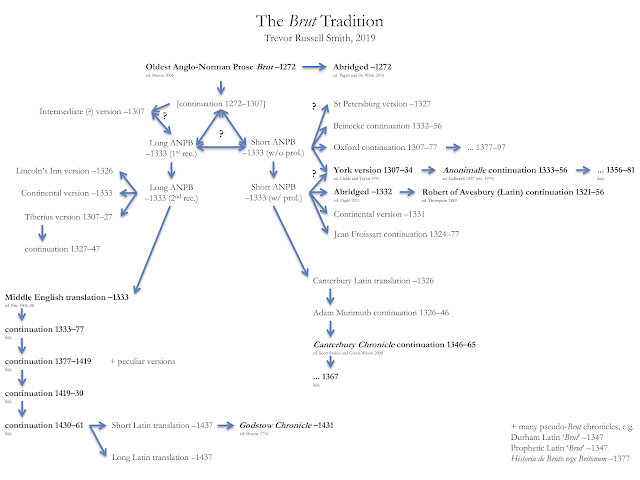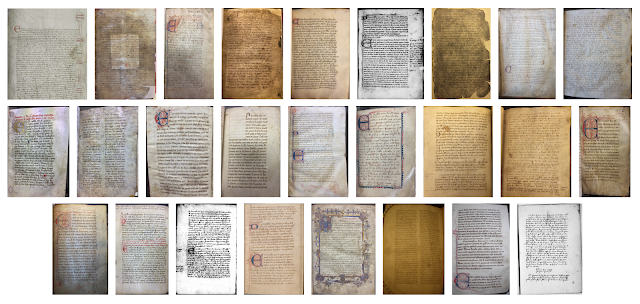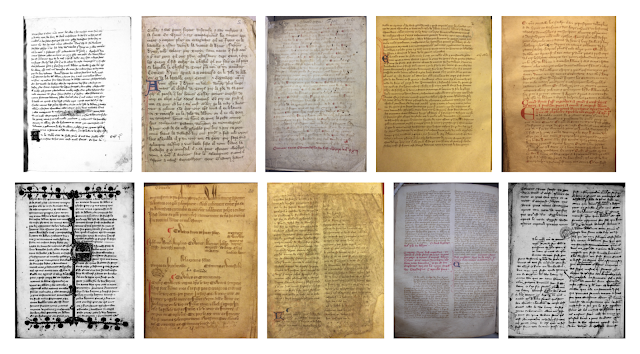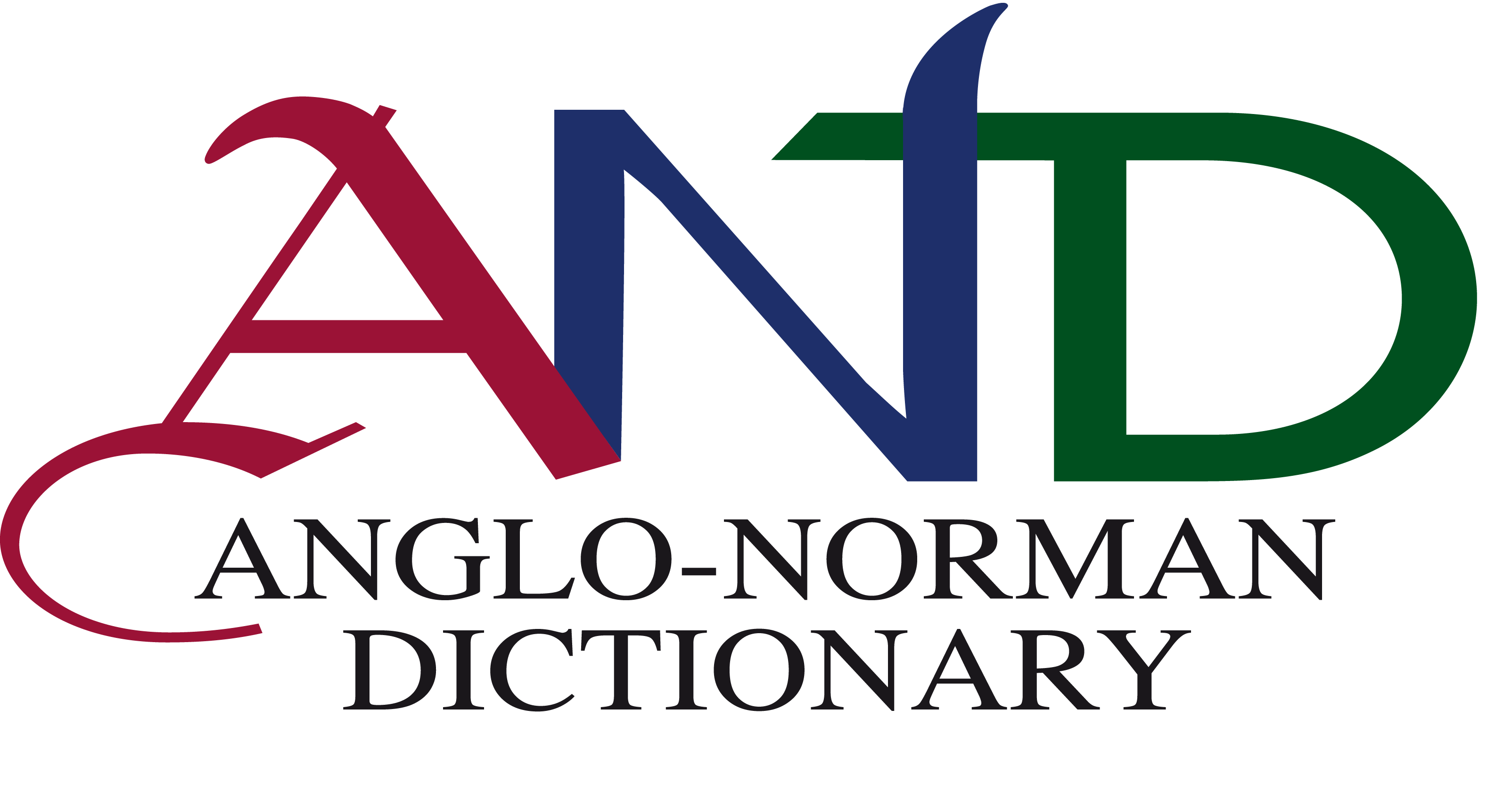The Anglo-Norman Prose ‘Brut’ Tradition
[A guest blog post by Dr. Trevor Russell Smith, who visited the Anglo-Norman Dictionary project in 2018 and 2019 through a AHRC bursary]
Latin was the standard language in which one wrote historical literature in England through the fifteenth century, although chronicles, annals, histories, and poems on contemporary and past events were sometimes written in the vernacular. The fourteenth century is commonly seen as the point in which the vernacular of choice shifted from Anglo-Norman French to Middle English. While the latter has received a huge amount of attention over the past few centuries, in no small part due to nationalism and it being more justifiably studied in the classroom, Anglo Norman has been neglected. This is immediately evident when one seeks to examine the historical literature written in the fourteenth century, this supposed transitional period. Gransden, in her widely used reference work, discusses many Latin texts but only three in Anglo Norman (the Anonimalle Chronicle, the French Chronicles of London, and Thomas Gray’s Scalacronica), each of which survives in a single manuscript each.[1] However, Dean and Boulton’s standard resource lists nearly every piece of Anglo-Norman literature and includes a large number of historical writings from this period.[2] A Manual of the Writings in Middle English likewise lists Middle English literature and has a much-cited volume dedicated solely to historical literature.[3] A quick glance at Dean and Boulton, however, will make it evident that most Anglo-Norman historical literature of the fourteenth century remains unpublished, with a few texts in mostly-inaccessible PhD theses of sometimes dubious quality. Accordingly, the bulk of attention on vernacular historical literature in the period is given to writings in Middle English, especially the Middle English Prose Brut. Indeed, the MEPB is often examined over its immediate source, the Anglo-Norman Prose Brut, in no small part due to it being available in a convenient (and now digitised) Early English Text Society edition, but also because the tradition is incredibly complex and not yet fully worked out.[4]
The prose Brut chronicle, narrating Britain’s history from its legendary foundation to the later Middle Ages, was the most widely read secular text in late medieval England. Originally written in French, it soon received continuations and was developed into many versions in English and Latin, thanks to England’s multilingual environment. In total these survive in well over two hundred manuscripts. Its popularity was partly due to its genre defying style, colourful stories, and propagandistic attitude. These traits, however, have driven editors to ignore the Brut in favour of explicitly literary and historical texts. A few manuscripts of the English and Anglo-Norman texts after the Oldest ANPB have been edited, but none are representative and their editors do not examine them in relation to the others (see diagram below).[5] The textual traditions have similarly been studied only in isolation and without proper cross-language examination. Brie knew of only two-thirds of the manuscripts and examined them briefly. Matheson, while he created the standard resource on the English manuscripts, was not interested in the Anglo-Norman or Latin manuscripts and only briefly mentioned them. Marvin has inspected some manuscripts of the Short and Long ANPB texts in detail, but has not performed a comprehensive examination of the textual tradition.[6] Subsequent studies of thematic elements of the Brut texts, such as genealogy, prophecy, and Arthurian stories, have been severely limited due to our poor understanding of the development and dissemination of the Brut.

The Brut tradition
*click here for a larger image*
While the development of the various versions of the MEPB are fairly linear, the ANPB’s tradition remains tangled and has yet to be properly worked out. The Oldest ANPB (to 1272) survives in five manuscripts, with another peculiar manuscript not used in Marvin’s edition and an abridged text in a manuscript edited by Pagan and De Wilde. After this, however, it gets difficult. The Short and Long ANPBs (in 16 and 32 manuscripts) both use the Oldest ANPB as their base text through 1272, then have a very similar continuation for 1272–1307, but have independent continuations for 1307–33. The Short ANPB copies over its –1272 text fairly closely, but the Long ANPB makes many changes, most notably the inclusion of prophecies on the reigns of English kings. To make things worse, there are two major recensions of the Long ANPB that have many differences throughout, not only in choice of words or paraphrasing, of which there is plenty. The most troubling element is the 1272–1307 continuation, based on Pierre de Langtoft’s chronicle, as it prevents any sort of linear or otherwise straightforward relationship.[7] Was there an Intermediate ANPB that carried on through 1307 but no longer survives?[8] Was the Short ANPB written through 1333 first and then the writer of the Long ANPB took its text up to 1307 only, modified it, and then added on a continuation of his own to 1333 (or vice versa)? Were the Short and Long ANPBs written independently, with both of them coincidentally drawing on the Oldest ANPB to 1272 and Langtoft for 1272–1307? Or is the tradition more labyrinthine, like that of Piers Plowman?
Because of the more than 50 manuscripts involved, in libraries in the United Kingdom, France, Ireland, Russia, and the United States, scholars have yet to resolve these problems (although they have been happy to offer their theories without much supporting evidence), and therefore no proper critical editions have been produced of the main texts.[9] Even during the great push to create editions in the nineteenth century the ANPB texts were skipped over because they straddled the line between historical and literary text, and were also not in proper continental French or Middle English. These texts have thus, unfortunately, have languished in relative obscurity, despite their clear importance in the period.

The Short Anglo-Norman Prose Brut manuscripts, from left to right, first row: 1. Cambridge, Corpus Christi College, MS 98; 2. Cambridge, Jesus College, MS Q G 10; 3. Cambridge, University Library, MS Mm I 33; 4. London, British Library, MS Add. 35113; 5. London, British Library, MS Cotton Cleopatra D VII; 6. London, British Library, MS Cotton Domitian A X; 7. London, British Library, MS Cotton Julias A I; 8. New Haven, Yale University Beinecke Library, MS 86; 9. New Haven, Yale University Beinecke Library, MS 405; second row: 10. Oxford, Corpus Christi College, MS 78; 11. Oxford, Corpus Christi College, MS 293A; 12. Cambridge, Trinity College, MS R VII 14; 13. Cambridge, University Library, MS Gg I 15; 14. Dublin, Trinity College, MS 500; 15. Edinburgh, University Library, MS 181; 16. London, British Library, MS Add. 18462; 17. London, British Library, MS Harley 6359; 18. London, College of Arms, MS Arundel 31; third row: 19. London, Inner Temple, MS Petyt 511.19; 20. London, Lambeth Palace Library, MS 504; 21. London, Westminster Abbey, MS 25; 22. New Haven, Yale University Beinecke Library, MS 593; 23. Oxford, Bodleian Library, MS e Musaeo 108; 24. Oxford, Bodleian Library, MS Lyell 17; 25. Oxford, Bodleian Library, MS Rawlinson D 329; 26. Paris, Bibliothèque nationale de France, MS fr. 12156. Not pictured: St Petersburg, York, Abridged, and Continental versions.
*click here for a larger image*

The Long Anglo-Norman Prose Brut manuscripts, from left to right, first row: 1. Aberystwyth, National Library of Wales, MS 5028C; 2. Cambridge, University Library, MS Ii VI 8; 3. Dublin, Trinity College, MS 501; 4. London, British Library, MS Add 18462; 5. London, British Library, MS Royal 20 A III; second row: 6. London, British Library, MS Cotton Cleopatra D III; 7. London, British Library, MS Royal 20 A XVIII; 8. London, British Library, MS Royal Appendix 85; 9. Oxford, Bodleian Library, MS Ashmole 1804; 10. Paris, Bibliothèque Mazarine, MS 1860. Not pictured: Intermediate (?), Lincoln’s Inn, Continental, and Tiberius versions.
*click here for a larger image*
Besides the main texts there are several continuations and variant versions that have yet to be properly studied. The Short and Long ANPBs received further continuations in Anglo-Norman, only one of which has been edited. The so-called Anonimalle Chronicle continues a peculiar expanded section of the Short ANPB, which has also been edited, but cannot be taken as a representative text. One copy of the Short ANPB and another three copies of the Long ANPB (all independent, perhaps adapted from a single insular copy) are in continental French, with changes made throughout that deserve further scrutiny. There are many other versions of the main text as well, including two peculiar abridgments of the Long ANPB.

The Anglo-Norman Prose Brut continuation manuscripts, from left to right: 1. Leeds, University Library, MS Brotherton 29; 2. London, British Library, MS Cotton Tiberius A VI; 3. New Haven, Yale University Beinecke Library, MS 86; 4. New Haven, Yale University Beinecke Library, MS 593; 5. Oxford, Corpus Christi College, MS 78.
*click here for a larger image*

The Anglo-Norman Prose Brut continental manuscripts, from left to right: 1. Paris, Bibliothèque de l’Arsenal, MS 3346; 2. London, British Library, MS Royal 19 C IX; 3. Paris, Bibliothèque nationale de France, MS fr. 12155; 4. Paris, Bibliothèque Sainte-Geneviève, MS 935.
*click here for a larger image*
The Short ANPB (with prologue, presumably the second recension) was later translated (and abridged a bit) into Latin to form the first part of a four-part chronicle, the final two of which are known as the Canterbury Chronicle (or, Anonymous of Canterbury’s chronicle). This version of the Brut only goes to 1326 and, while it is tempting to presume that this was translated from the one copy of the Short ANPB that ends in the same year (Cambridge, University Library, MS Mm I 33), the transmission here requires further study. A manuscript of the second recension of the Long ANPB was translated into Middle English towards the end of the fourteenth century and soon received a continuation to 1377. This initial Middle English version only survives in a few manuscripts and likewise needs to be studied in more depth, especially in relation to its Anglo-Norman source. It has been presumed that a particular copy of the Long ANPB (London, British Library, MS Cotton Cleopatra D III) was the source because it has the same chapter divisions, but a word-for-word comparison of the MEPB with the Long ANPB shows this to be unlikely.

The Canterbury Latin Prose Brut manuscripts, from left to right: 1. London, British Library, MS Cotton Julius B III; 2. London, Lambeth Palace Library, MS 99; 3. Oxford, Magdalen College, MS Lat. 200; 4. Reigate, Parish Church of St Mary Cranston Library, Item 1117.
*click here for a larger image*

The Middle English Prose Brut (Common Version–1333) manuscripts, from left to right, first row: 1. Aberystwyth, National Library of Wales, MS Peniarth 398D; 2. Dublin, Trinity College, MS 490; 3. London, British Library, MS Harley 3945; 4. London, Society of Antiquaries, MS 93; 5. Manchester, Rylands Library, MS Eng. 103; second row: 6. Manchester, Rylands Library, MS Eng. 206; 7. New Haven, Yale University Beinecke Library, MS 494; 8. Oxford, Bodleian Library, MS Bodley 840; 9. Oxford, Bodleian Library, MS Douce 323; 10. Oxford, Bodleian Library, MS Rawlinson B 171. Not pictured: New York, Private Collection of J. D. Gordan, MS 63 (unavailable).
*click here for a larger image*
So, as you can see, from the Short and Long ANPBs sprung a wide variety of continuations, translations, and further continuations and translations. Indeed, the genre found wide popularity, thanks in no small part to its clearly political blending of mythology and history to establish England’s claim over all of Britain. Many pseudo-Brut chronicles were also written, some crafted from existing chronicles and others written more or less from scratch, all of which took on the general form of the Brut: a chronicle starting with the founding of Britain that methodically traces the line of rulers down to the (then) present day.[10]
It is therefore important for the Short and Long ANPBs to have their traditions sorted out and to receive proper editions (and thus allow work on variant versions, continuations, and translations to go forward). Since 2015 the British Library and more and more institutions, thankfully, now allow personal photography, which makes this sort of work more tenable than it was back in the days of pencils, notebooks, and microfilms (oh my!) While there are many more unedited and unknown chronicles from the period written in Latin, none are in the same level of detail, let alone with such a large readership, as the Short and Long ANPBs. The dearth of published Anglo-Norman history writing in the fourteenth century, combined with the almost total editing of all Middle English historical literature, has encouraged people to consider language, national identity, and the medieval understanding of the past in the later Middle Ages in a skewed fashion. This has obvious implications in many other areas of medieval studies.
I first came across the Brut and, in particular, the ANPB during my doctoral studies (2013–17). I was trying to perform a comprehensive examination of the historical literature written during the reign of Edward III (1327–77) so that I could arrive at a full(ish) understanding of attitudes towards various contemporary events at the time. I was shocked to find that the Short and Long ANPBs, such obviously important texts as they were, remained without proper editions (I was later more shocked to find so many other valuable chronicles unedited and almost entirely unknown!) I then sought to understand the dissemination and intended uses of these texts by listing the manuscripts and their contents. This led to further nightmarish yet rewarding research, which soon spiralled out of control despite the best efforts of my supervisors. All the while I kept thinking about, and doing little bits of work on the ANPB tradition, as it was the only one of my unedited texts for which the tradition remained unresolved. In the end I examined 303 manuscripts, almost all in person, visited 35 manuscript libraries, and wrote a 61-page appendix to my thesis. Indeed, probably 90% of this work on manuscripts and my appendix had absolutely nothing to do with the argument of my thesis, but rather stemmed from a desire to understand what was written and how the different versions of each text related to each other. This work has helped me move my research in new and interesting directions that I never would have considered had I not begun to examine the ANPB.
During my time at Aberystwyth and the Anglo-Norman Dictionary I was able to examine an important copy of the Long ANPB and other copies of the MEPB in the National Library of Wales. I was also able to discuss the above problems with Heather Pagan and Geerte De Wilde, editors of the Anglo-Norman Dictionary, both of whom have worked on different versions of the ANPB, and also make use of the excellent resources of the AND. The Anglo-Norman Dictionary scholarship allowed me to keep working on this difficult subject so that I could complete my PhD (and appendix). It has also provided me with invaluable resources to continue doing research on the difficult problem of the ANPB tradition.
I am currently preparing applications for three-year postdoctoral fellowships so that I can carry out and complete this project. My study of the Brut tradition and the three languages of England will disprove the common assertion that English identity only properly developed in the Middle English literary canon, especially from the late fourteenth century onwards. The outputs of the project will provide valuable insight into the development of the tradition and how it reflects ideals and attitudes towards the late-medieval world. Most importantly, however, it will allow critical editions of the various texts to finally be produced, and also help the ANPB to retake its place amongst the key writings of late medieval England.
Trevor Russell Smith
University of Leeds
ego_chronicon@outlook.com
[1] Antonia Gransden, Historical Writing in England, 2 vols (London: Routledge, 1974–82), vol. 2. While Taylor discusses the Anglo-Norman writings in more detail, his work is more of a synthesis of his previous works than a reference work: John Taylor, English Historical Literature in the Fourteenth Century (Oxford: Clarendon Press, 1987).
[2] Ruth J. Dean and Maureen B. M. Boulton, Anglo-Norman Literature: A Guide to Texts and Manuscripts, Anglo-Norman Text Society, Occasional Publications Series, 3 (London: Anglo-Norman Text Society, 1999), pp. 1–65.
[3] A Manual of the Writings in Middle English, 1050–1500, ed. by Burke J. Severs, Albert E. Hartung, and Peter G. Beidler, 11 vols so far (New Haven: Connecticut Academy of Arts and Sciences, 1967–), vol. 8.
[4] See n. 5 below.
[5] For texts cited in the diagram see ‘Anonymi chronicon Godstovianum’, in Guilielmi Roperi vita D. Thomae Moriequitis aurati, ed. by Thomas Hearne (Oxford: Veneunt apud editorem, 1716), pp. 180–246; Robert of Avesbury, ‘De gestis mirabilibus regis Edwardi tertii’, in Adae Murimuth; Robertus de Avesbury, ed. by Edward Maunde Thompson, Rolls Series, 93 (London: Eyre, 1889), pp. 279–471; The Brut, or the Chronicles of England, ed. by Friedrich W. D. Brie, Early English Text Society, Original Series, 131, 136, 2 vols (London: Paul, 1906–08); The Anonimalle Chronicle, 1333 to 1381, from a MS Written at St Mary’s Abbey, York, ed. by Vivian H. Galbraith, rev. edn (Manchester: Manchester University Press, 1970); The Anonimalle Chronicle, 1307 to 1334, from Brotherton Collection MS 29, ed. by Wendy R. Childs and John Taylor, Yorkshire Archaeological Society, Record Series, 147 (Leeds: Yorkshire Archaeological Society, 1991); The Oldest Anglo-Norman Prose ‘Brut’ Chronicle, ed. by Julia Marvin (Woodbridge: Boydell, 2006); Canterbury Anonymous, Chronicon: Chronicle, 1346–1365, ed. by Charity Scott-Stokes and Chris Given-Wilson, Oxford Medieval Texts (Oxford: Clarendon Press, 2008); Prose Brut to 1332, ed. by Heather Pagan, Anglo-Norman Text Society, Annual Texts, 69 (Manchester: Manchester University Press, 2011); ‘The Anglo-Norman Prose Chronicle of Early British Kings, or the Abbreviated Prose Brut: Text and Translation’, ed. by Heather Pagan and Geert De Wilde, Medieval Chronicle, 10 (2015), 225–319.
[6] Friedrich W. D. Brie, Geschichte und Quellen der mittelenglischen Prosachronik ‘The Brute of England’ oder ‘The Chronicles of England’ (Marburg: Friedrich, 1905); Lister M. Matheson, The Prose ‘Brut’: The Development of a Middle English Chronicle (Tempe: Medieval & Renaissance Texts & Studies, 1998); Julia Marvin, The Construction of Vernacular History in the Anglo-Norman Prose ‘Brut’ Chronicle: The Manuscript Culture of Late Medieval England (Woodbridge: York Medieval Press, 2017).
[7] Pierre de Langtoft, Le Règne d’Édouard Ir: Édition critique et commentée, ed. by Jean Claude Thiolier (Créteil: C.E.L.I.M.A., Université de Paris XI, 1989).
[8] Two MSS end at 1307, but the first of these is an abridged early version of the Long ANPB and the latter of these is a peculiar version of the Short ANPB: Cambridge, University Library, MS Ee I 20; Oxford, Corpus Christi College, MS 78.
[9] One MS of the Long ANPB has been transcribed, but it is not from a representative MS, is not compared to any of the other MSS, and has many errors throughout: ‘The Anglo-Norman Prose Brut: An Edition of British Library, MS Cotton Cleopatra D III’, ed. by Marcia Lusk Maxwell (unpublished doctoral dissertation, Michigan State University, 1995).
[10] See for example how Tyson unhelpfully lumps both pseudo-Brut and Brut-proper manuscripts together: Diana B. Tyson, ‘Handlist of Manuscripts Containing the French Prose Brut Chronicle’, Scriptorium, 48 (1994), 333–44.
